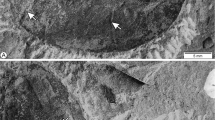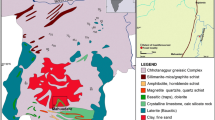Abstract
Four legume fruits (Fabaceae) from the Siwalik sediments (middle Miocene to lower Pleistocene) of Darjeeling and Arunachal Pradesh of Eastern Himalaya are described here. One fossil fruit, Dalbergia prelatifolia sp. nov., is recovered from the lower part of the Siwalik succession (Gish Clay Formation of Sevok Group; middle to upper Miocene) of Darjeeling foothills. Mastertia neoassamica sp. nov. and Acacia miocatechuoides sp. nov. are collected from the lower part of the Siwalik succession (Dafla Formation; middle Miocene to upper Miocene), while Pongamia kathgodamensis Prasad is recovered from the upper part of the Siwalik succession (Kimin Formation; upper Pliocenelower Pleistocene) of Arunachal sub Himalaya. Their presence indicates a warm and humid tropical environment in the region during the Siwalik sedimentation.
Similar content being viewed by others
References
Acharya, S.K. (1994) The Cenozoic foreland basin and tectonics of the Eastern Sub-Himalaya Problem and Prospects. Himalayan Geol., v.15, pp.3–21.
Agarwal, A. (2003) A carbonized fossil seed, viz., Entada palaeoscandens (Awasthi and Prasad) Antal and Awasthi from lignite deposits of Kalviwadi, Sindhudurg, Maharashtra, India. Phytomorphology, v.53, pp.1–7.
Agarwal, A. (2008) Angiospermous fossil fruits/seeds during Tertiary in India. Palaeobotanist, v.57, pp.165–175.
Antal, J.S. and Awasthi, N. (1993) Fossil flora from the Himalayan foot-hills of Darjeeling district, West Bengal and its palaeoecological and phytogeographical significance. Palaeobotanist, v.42(1), pp.14–60.
Antal, J.S. and Prasad, M. (1995) Fossil leaf of Clinogyne Salisb. from the Siwalik sediments of Darjeeling District, West Bengal. Geophytology, v.24, pp.241–243.
Antal, J.S. and Prasad, M. (1996a) Some more leaf-impressions from the Himalayan foothills of Darjeeling District, West Bengal, India. Palaeobotanist, v.43, pp.1–9.
Antal, J.S. and Prasad, M. (1996b) Dipterocarpaceous fossil leaves from Grish River section in Himalayan foot hills near Oodlabari, Darjeeling District, West Bengal. Palaeobotanist, v.43, pp.73–77.
Antal, J. S. and Prasad, M. (1996c) Leaf-impressions of Polyalthia Bl. in the Siwalik sediments of Darjeeling District, West Bengal. Geophytology, v.26, pp.125–127.
Antal, J.S. and Prasad, M. (1997) Angiospermous fossil leaves from the Siwalik sediments (Middle-Miocene) of Darjeeling District, West Bengal. Palaeobotanist, v.46(3), pp.95–104.
Antal, J.S. and Prasad, M. (1998) Morphotaxonomic study of some more fossil leaves from the lower Siwalik sediments of West Bengal, India. Palaeobotanist, v.47, pp.86–98.
Antal, J.S., Prasad, M. and Khare, E.G. (1996) Fossil woods from the Siwalik sediments of Darjeeling district, West Bengal, India. Palaeobotanist, v.43(2), pp.98–105.
Awasthi, N. (1992) Indian fossil legumes; Advances in legume Systematics: Part 4. The Fossil Record. pp.225–250.
Awasthi, N. and Mehrotra, R.C. (1995) Oligocene flora from Makum Coalfield, Assam, India. Palaeobotanist, v.44, pp.157–188.
Awasthi, N. and Prasad, M. (1990) Siwalik plant fossils from Surai Khola area, western Nepal. Palaeobotanist, v.38, pp. 298–318.
Bande, M. B. and Srivastava, G. P. (1990) Late Cenozoic plant impressions from Mahuadanar valley, Palamu district, Bihar. Palaeobotanist, v.37, pp.331–366.
Banerji, J. (2000) Occurrence of angiosperm remains in an Early Cretaceous intertrappean bed, Rajmahal basin, India. Cretaceous Res., v.21, pp.781–784.
Bera, S. and Khan, M. (2009) Record of fruit and leaflet cf. Pongamia pinnata (L.) Pierre from the upper Siwalik sediments (Kimin Formation) of Arunachal Pradesh. In: S. Mondal and S. Bhattacharya (Eds.), Advances in Plant Biology (Debasis Bhattacharya Birth Centenary Commemorative Volume), pp.432–441.
Bera, S., De, A. and De, B. (2003) First record of Elaeocarpus Linn. Fruits from the upper Siwalik sediments (Kimin Formation) of Arunachal Pradesh, India. Jour. Geol.Soc. India, v.64, pp.350–352.
Bhattacharyya, B. (1985) Leguminous fruits from the Eocene of Garo Hills, Meghalaya. Jl. Geol. Min. Metall. Soc. India, v. 57(4), pp.215–225.
Brandis, D. (1971) Indian trees, Bishen Singh, Mahenra Pal Singh, Deradun.
Gamble, J.S. (1972) A manual of Indian timbers. Bishen Singh Mahendra Pal Singh, Deradun, 868.
Ganguly, S. and Rao, D.P. (1970) Stratigraphy and structure of the Tertiary foothills of Eastern Himalaya. Darjeeling district; W. B. Quart. Jour. Min. Met. Soc. India, v.42(4), pp.185–195.
Guleria, J. S., Hemanta Singh, R. K., Mehrotra, R. C., Soibam, I. and Kishor, R. (2005) Palaeogene plant fossils of Manipur and their palaeoecological significance. Palaeobotanist, v.54, pp.67–77.
Hably, L. (1992) Distribution of legumes in the Tertiary of Hungary. Advances in legume Systematics: Part 4. The Fossil Record, pp.169–187.
Hazra, P.K., Verma, D.M. and Giri, G.S. (Eds.) (1996) Materials for the flora of Arunachal Pradesh. Botanical Surv. India, v.1, pp.693.
Joshi, A. and Mehrotra, R.C. (2007) Megaremains from the Siwalik sediments of West and East Kameng Districts, Arunachal Pradesh. Jour. Geol. Soc. India, v.69, pp.1256–1266.
Joshi, A., Tewari, R., Mehrotra, R. C., Chakraborty, P. P. and De, A. (2003) Plant remains from the Upper Siwalik sediments of West Kameng District, Arunachal Pradesh. Jour. Geol. Soc. India, v.61, pp.319–324.
Khan, M. and Bera, S. (2007) Dysoxylum miocostulatum sp. nov.-a fossil leaflet of Meliaceae from the Lower Siwalik sediments of West Kameng district, Arunachal Pradesh, Eastern India. Indian Jour. Geol., v.79(3–4), pp.63–68.
Khan, M. and Bera, S. (2010) Record of fossil fruit wing of Shorea Roxb. from the Neogene of Arunachal Pradesh. Curr. Sci., v.98(12), pp.1573–1574.
Khan, M., De, B. and Bera, S. (2008) Fossil leaves resembling modern Terminalia chebula Retzius from the Lower Siwalik sediments of Arunachal Pradesh, India. Pleione, v.2, pp.38–41.
Khan, M., De, B. and Bera, S. (2009) Leaf-impressions of Calophyllum L. from the Middle Siwalik sediments of Arunachal Sub-Himalaya, India. Pleione, v.3(1), pp.101–106.
Khan, M., Gupta, S., Parua, D., De, A., De, B. and Bera, S. (2006) Palynoassemblage from Upper Siwalik sediments of Papumpare district, Arunachal Pradesh with remarks on palaeoenvironment. Jour. Botanical Soc. Bengal, v.60, pp.1–5.
Khan, M., Ghosh, R., Bera, S., Spicer, R. A. and Spicer, T.E.V. (2011) Floral diversity during Plio-Pleistocene Siwalik sedimentation (Kimin Formation) in Arunachal Pradesh, India, and its palaeoclimatic significance. Palaeodiversity and Palaeoenvironment, v.91, pp.237–255.
Kumar, G. (1997) Geology of Arunachal Pradesh. Geol. Soc. India, Bangalore, pp. 1–217
Lakhanpal, R. N. and Dayal, R. (1966) Lower Siwalik plants from near Jawalamukhi, Punjab. Curr. Sci., v.35, pp.209–211.
Lakhanpal, R.N. and Guleria, J.S. (1982) Plant remains from the Miocene of Kachchh, Western India. Palaeobotanist, v.30, pp.279–296.
Mehrotra, R.C. (2000) Study of plant megafossils from the Tura Formation of Nangwalbibra, Garo Hills, Meghalaya, India. Palaeobotanist, v.49(2), pp.225–237.
Mehrotra, R.C. and Mandaokar, B.D. (2002) A new leguminocarpus fruit from the middle Bhuban Formation of Aizwal, Mizoram. Jour.Geol. Soc. India, v.60, pp.465–466.
Mehrotra, R.C. (2003) Status of plant megafossils during the early Paleogene in India. Geol. Soc. Amer., Special Paper, 369.
Mehrotra, R.C., Awasthi, N. and Dutta, S.K. (1999) Study of fossil wood from the Upper Tertiary sediments (Siwalik) of Arunachal Pradesh, India and its implication in palaeoecological and phytogeographical interpretations. Review of Paleobotany and Palynology, v.107, pp.223–247.
Mitra, S., Bera, S. and Banerjee, M. (2000) Palynofloral assemblage from Siwalik foredeep Neogene sediments of Darjeeling foothills, Eastern Himalaya. Geophytology, v.28 (1&2), pp.121–127.
Mitra, S. and Banerjee, M. (2004) Fossil fruit Derrisocarpon miocenicum gen. et. sp. nov. and leaflet Derrisophyllum Siwalicum gen. et. sp. nov. cf. Derris trifolita Lour. of Fabaceae from Siwalik sediments of Darjeeling Foothills, Eastern Himalaya, India with remarks on site of origin and distribution of the genus. Phytomorphology, v.54 (3–4), pp.253–263.
Pathak, N.R. and Banerjee, M. (1984) Fungal spores from the Neogene sediments of the Eastern Himalayan foothills, Darjeeling district. Proc. X Ind. Coll. Micropal. and Strat., pp.245–260.
Prasad, M. (1994a) Plant megafossils from the Siwalik sediments of Koilabas, central Himalaya, Nepal and their impact on palaeoenvironment. Palaeobotanist, v.42, pp.126–156.
Prasad, M. (1994b) Morphotaxonomical study on angiospermous plant remains from the foot hills of Kathgodam, north India. Phytomorphology, v.44, pp.115–126.
Prasad, M. (2008) Angiospermous fossil leaves from the Siwalik foreland basins and their palaeoclimatic implications. Palaeobotanist, v.57, pp.177–215.
Prasad, M. and Awasthi, N. (1996) Contribution to the Siwalik flora from Surai Khola sequence, western Nepal and its palaeoecological and phytogeographical implications. Palaeobotanist, v.43, pp.1–42.
Prasad, M., Antal, J. S., Tripathi, P. P. and Pandey, V.K. (1999) Further contribution to the Siwalik flora from the Koilabas area, western Nepal. Palaeobotanist, v.48, pp.49–95.
Prasad, M., Ghosh, R. and Tripathi, P.P. (2004) Floristics and climate during Siwalik (Middle Miocene) near Kathgodam in the Himalayan foot-hills of Uttranchal, India. Jour. Paleaont. Soc. India, v.49, pp.35–93.
Prasad, M., Agarwal, A. and Ambwani, K. (2007) Record of a fossil fruit of a coastal plant from the Baragolai Formation, Assam, India. Jour. Appld. Biosci., v.33(1), pp.42–44.
Shakryl, A.K. (1992) Leguminosae species from Tertiary of Abkhazia. Advances in legume Systematics: Part 4. The Fossil Record, pp.189–206.
Singh, T. and Tripathi, S.K.M. (1990) Siwalik sediments of Arunachal Himalaya: Palynology, palaeoecology and palaeogeography. Palaeobotanist, v.38, pp.325–332.
Srivastava, R and Mehrotra, R.C. (2009) Plant fossils from Dafla Formation, West Kameng District, Arunachal Pradesh. Palaeobotanist, v.58, pp.33–49.
Srivastava, G. and Mehrotra, R.C. (2010) New legume fruits from the Oligocene sediments of Assam. Jour. Geol. Soc.India, v.75, pp.820–828.
Srivastava, R. and Krassilov, V.A. (2012) Revision of Early Cretaceous angiosperm remains from the Rajmahal Basin, India, with notes on the palaeoecology of the Pentoxylon plant. Cretaceous Res., v.33, pp.66–71.
Tiwari, R.P. and Mehrotra, R.C. (2002) Plant impressions from the Barail Group of Champhai-Aizawl road section, Mizoram, India. Phytomorphology, v.52, pp.69–76.
Author information
Authors and Affiliations
Corresponding author
Rights and permissions
About this article
Cite this article
Khan, M.A., Bera, S. On some fabaceous fruits from the Siwalik sediments (Middle Miocene-Lower Pleistocene) of Eastern Himalaya. J Geol Soc India 83, 165–174 (2014). https://doi.org/10.1007/s12594-014-0028-z
Received:
Revised:
Published:
Issue Date:
DOI: https://doi.org/10.1007/s12594-014-0028-z




